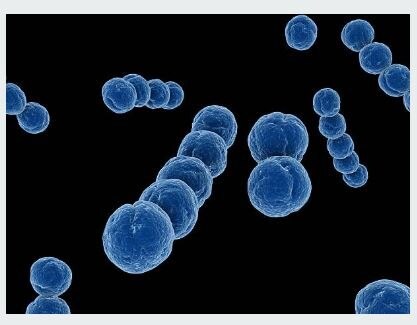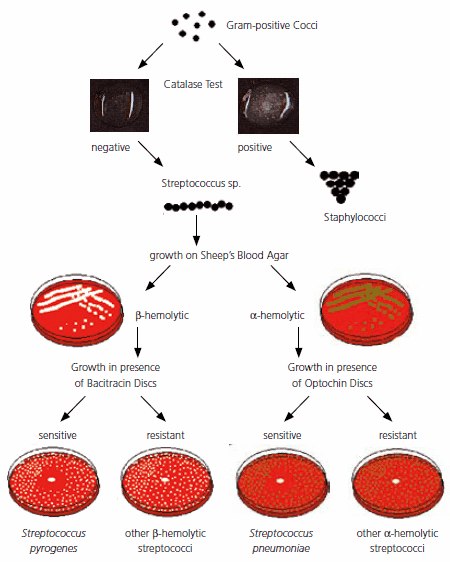Streptococci - Overview of Detection, Identification, Differentiation and Cultivation Techniques
Streptococci are non-motile, microaerophilic, Grampositive spherical bacteria (cocci). They often occur as chains or pairs and are facultative or strict anaerobes. Streptococci give a negative catalase test, while staphylococci are catalase-positive. The cell division of Streptococci species involves two separate biosynthetic events: peripheral cell-wall elongation and septal-wall synthesis.1 Because they are unable to synthesize cytochromes, Streptococci cannot carry out oxidative phosphorylation. They are able to ferment sugars, but the end product is always lactic acid. Therefore, Streptococci are very acid tolerant and count among the lactic acid bacteria order.
There are many natural sources of Streptococci, including humans and diverse animals where they often colonize the mucosal surfaces of mouth, intestinal tract, nasal passages and pharynx. The presence of Streptococci in drinking water indicates fecal contamination. Food sources with high risk of Streptococcal contamination include milk and dairy products, eggs, steamed lobster, ground ham, potato salad, custard, rice pudding and shrimp salad. In most Streptococcal food poisoning cases, the food was allowed to stand at room temperature for several hours between preparation and consumption. The contamination of the food is most often the result of poor hygiene, handling of the food by infected people, or the use of raw (unpasteurized) milk. Although they can be potent pathogens, some Streptococci are commercially important for the production of cheese and yogurt. These include S. lactis, S. cremoris, S. diacelillactis and S. thermophilus, the latter being the most well-known.
For detection, identification, differentiation, enumeration and cultivation of Streptococci, we provide a broad range of specific agars and broths (Table 1), Streptococci Diagnostic Tests (Table 2) and a Gram staining kit and component solutions (Table 3).

Scientific classification of Streptococcus
Kingdom: Eubacteria
Phylum: Firmicutes
Class: Bacilli
Order: Lactobacillales
Family: Streptococcaceae
Genus: Streptococcus
Grouping of Streptococci based on hemolytic activity
Streptococci are divided into three groups based on their hemolytic (red blood cell lysing) activity. The hemolytic reaction can be visualized on blood agar plates, such as the non-selective Agars for Differentiation that are listed in Table 1.
Non-selective Enrichment Broths
Selective Enrichment Broths
Non-selective Agars for Cultivation, Enumeration and Isolation
Non-selective Agars for Differentiation
Selective Agars with Differential System for Differentiation, Detection and Isolation
Media for Sensitivity Testing
Alpha-Hemolytic Streptococci
In alpha hemolysis, the red blood cells remain intact, but the hemoglobin is converted to biliverdin. This causes dark greening of the blood agar plate around the colonies.
- Pneumococci
S. pneumoniae: Causes bacterial pneumonia, otitis media and meningitis. S. pneumoniae sensitivity to optochin (ethyl hydrocupreine hydrochloride) is the basis of a diagnostic test (Figure 1, Table 2).

Figure 1.Differentiation and identification flow chart of Gram-positive cocci
- Viridans and Others
S. mutans: Associated with dental caries.
S. viridans: Causative agent for endocarditis and dental abscesses.
S. salivarius: Considered to be an opportunistic pathogen.
S. salivarius subsp. thermophilus: Used in the production of cheese and yogurt.
Beta-Hemolytic Streptococci
Beta hemolysis is a complete hemolysis of erythrocytes by the enzyme hemolysin. Clear zones will appear around the colonies on the blood agar plate. Beta-hemolytic Streptococci are further divided into serological groups using specific antibodies that recognize surface carbohydrate antigens (e.g. A, B, etc.).
- Group A
S. pyogenes: Causes infections like strep throat, acute rheumatic fever, scarlet fever, acute glomerulonephritis and necrotizing fasciitis. It is sensitive to bacitracin (Fig. 1), a fact that is employed in a Streptococcus diagnostic test (Table 2). Other Streptococci species may also possess the Group A antigen but are not human pathogens. These include S. dysgalactiae subsp. equisimilis and S. anginosus strains. - Group B
S. agalactiae: Causes meningitis in neonates and the elderly. Occasionally colonizing the female reproductive tract, they increase the risk for premature rupture of membranes and transmission of the infection to the child. - Group C
S. equi: Causes strangles infection in horses.
S. zooepidemicus: Causes infections in cattle, horses and other mammals. - Group D (Enterococci)
Many former Group D Streptococci have been reclassified to the genus Enterococcus (e.g. S. faecalis, S. faciem, S. durans, S avium).
S. bovis and S. suis: Still in the Group D streptococci.
Non-Hemolytic or Gamma-Hemolytic Streptococci
Gamma hemolysis is a misnomer as there is actually no hemolysis. Non-hemolytic or gamma-hemolytic Streptococci rarely cause disease.
Materials
References
To continue reading please sign in or create an account.
Don't Have An Account?